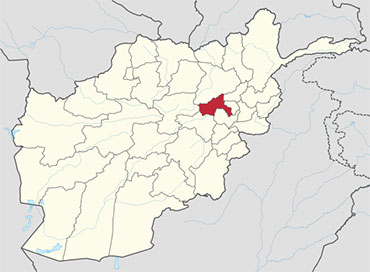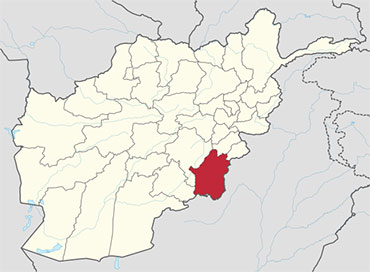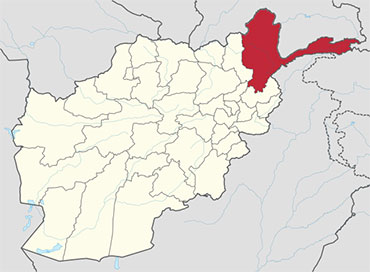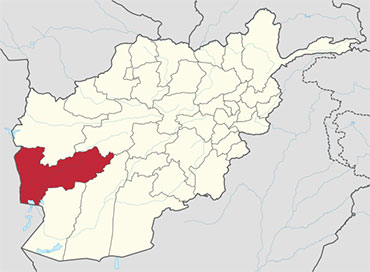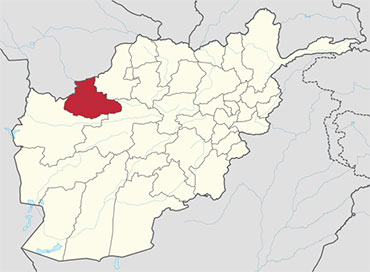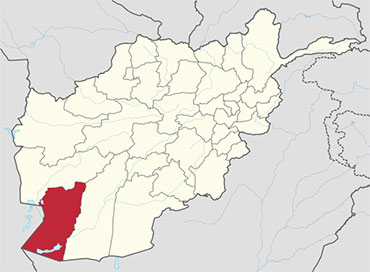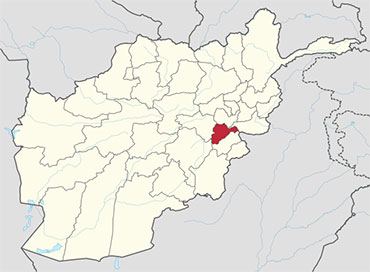 Logar is one of the 34 provinces of Afghanistan, located in the eastern section of the country. It is divided into eight districts and contains hundreds of villages. Pul-i-Alam is the capital of the province.
Logar is one of the 34 provinces of Afghanistan, located in the eastern section of the country. It is divided into eight districts and contains hundreds of villages. Pul-i-Alam is the capital of the province.
As of 2013, Logar has a population of about 373,100. It is a multi-ethnic tribal society, with about 60% belonging to the Pashtun group and the rest being Tajiks and Hazaras.
The word of Logar is a combination of two Pashto words: Loy (لوى “Big”) and Ghar (غر “mountain”). The Logar River enters the province through the west and leaves to the north.
History
The Logar province territory fell to the Maurya Empire, which was led by Chandragupta Maurya. The Mauryas introduced Buddhism to region, and were planning to capture more territory of Central Asia until they faced local Greco-Bactrian forces. Seleucus is said to have reach a peace treaty with Chandragupta by given control of the territory south of the Hindu Kush to the Mauryas upon intermarriage and 500 elephants.
Alexander took these away from the Indo-Aryans and established settlements of his own, but Seleucus Nicator gave them to Sandrocottus (Chandragupta), upon terms of intermarriage and of receiving in exchange 500 elephants.
— Strabo, 64 BCE–24 CE
Some time after, as he was going to war with the generals of Alexander, a wild elephant of great bulk presented itself before him of its own accord, and, as if tamed down to gentleness, took him on its back, and became his guide in the war, and conspicuous in fields of battle. Sandrocottus, having thus acquired a throne, was in possession of India, when Seleucus was laying the foundations of his future greatness; who, after making a league with him, and settling his affairs in the east, proceeded to join in the war against Antigonus. As soon as the forces, therefore, of all the confederates were united, a battle was fought, in which Antigonus was slain, and his son Demetrius put to flight.
Newly excavated Buddhist stupa at Mes Aynak in Logar Province of Afghanistan. Similar stupas have been discovered in neighboring Ghazni Province, including in the northern Samangan Province.
Having consolidated power in the northwest, Chandragupta pushed east towards the Nanda Empire. Afghanistan’s significant ancient tangible and intangible Buddhist heritage is recorded through wide-ranging archeological finds, including religious and artistic remnants. Buddhist doctrines are reported to have reached as far as Balkh even during the life of the Buddha (563 BCE to 483 BCE), as recorded by Husang Tsang.
In this context a legend recorded by Husang Tsang refers to the first two lay disciples of Buddha, Trapusa and Bhallika responsible for introducing Buddhism in that country. Originally these two were merchants of the kingdom of Balhika, as the name Bhalluka or Bhallika probably suggests the association of one with that country. They had gone to India for trade and had happened to be at Bodhgaya when the Buddha had just attained enlightenment.
During the Soviet war in Afghanistan, Logar was known among some Afghans as the Bab al-Jihad (Gates of Jihad) because it became a fierce theatre of war between US-backed/trained mujahideen groups and the Soviet-backed Afghan government troops. It was one of the main supply routes of mujahideen rebels coming from Pakistan. Like other parts of the country, Logar has also seen heavy fightings during the 1980s. Swedish journalist Borge Almqvist, who visited the province in 1982, wrote that: “Everywhere in the Logar province the most common sight except for ruins are graves”.Almqvist, Borge (1984). Committee for International Afghanistan Hearing, ed. International Afghanistan Hearing. Soviet operations included using bombing, the use of flammable liquids to burn alive people in hiding, poisoning of drinking water, and destruction of crops and farmland. One writer who witnessed the events argue that the Soviet actions in Logar amounted to genocide. Some of the notable rebel fighters were Fazlullah Mujaddidi, Sayed Rasool Hashimi, Malim Tor, Mohammad Wali Nasiri, Asadullah Fallah.
By 1995 the province had fallen to the Taliban government. After the removal of the Taliban and formation of the Karzai administration in late 2001, the International Security Assistance Force (ISAF) and Afghan National Security Forces (ANSF) gradually took over security of the area. Provincial Reconstruction Team Logar Provincial Reconstruction Team]] (PRT Logar) was established in March 2008. It provided a number of benefits to the locals, including security, development, and jobs.
In the meantime, Taliban insurgents are often causing major disturbances in the area. This includes major attacks on key projects, suicide bombings in civilian area, and assassinations of Afghan government employees. On 19 August 2014, a major Taliban offensive took place with 700 militants aiming to take control of the province, while the NATO-led foreign force mistakenly killed three civilians in an air strike in Dec 2014.
Healthcare
The percentage of households without clean drinking water fell from 45% in 2005 to 14% in 2011. The percentage of births attended to by a skilled birth attendant increased from 9% in 2005 to 73% in 2011.
Demography
As of 2013, the total population of Logar province is about 373,100,[1] which is multi-ethnic and a tribal society. About 60 percent of Logar’s residents belong to the Pashtun group; Tajiks and Hazaras form the remainder of the population.
Districts
Laghman province is divided into about 6 districts.
| District | Population | Area |
|---|---|---|
| Azra | 20,760 | |
| Baraki Barak | 89,476 | |
| Charkh | 45,362 | |
| Kharwar | 26,762 | |
| Khoshi | 24,602 | |
| Mohammad Agha | 77,074 | |
| Pul-i-Alam | 108,039 |
